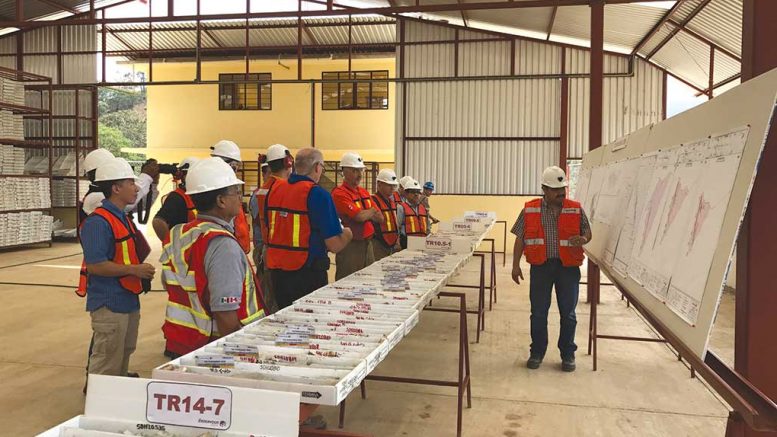Endeavour Silver’s (TSX: EDR; NYSE: EXK) 100%-owned Terronera project in Mexico’s Jalisco state would produce 3.3 million oz. payable silver and 32,874 oz. gold annually over a 12-year underground mine life, according to a feasibility study.
The study, which follows a prefeasibility study completed at the end of July 2020, modeled an underground mine processing 7.4 million tonnes of mineralized material at a rate of 1,700 tonnes per day. The life-of-mine all-in sustaining cost per oz. silver, net of gold credits, was pegged at US$3.24 per ounce.
At a base case gold price of US$1,800 per oz. and US$24 per oz. silver, the mine would generate an after-tax net present value at a 5% discount rate of US$174 million and an internal rate of return of 21.3% according to the study. Life-of-mine annual after-tax free cash flow once in full year production was forecast to run to US$40 million.
Initial capex of US$175 million, which would be spent over a 24-month period, could be paid back in 3.6 years. Sustaining capital would come in at about US$105.7 million with over 60% of that sum spent in the first three operating years for the phased underground development.
Dan Dickson, the company’s CEO, said the feasibility study results “support the construction of our largest, and lowest cost mine,” and noted that management believes “there are further opportunities to optimize the project and grow the mineral resource … [and] with continued drilling success, there is potential to add significant production ounces and mine life at Terronera.”

Drillers at Endeavour Silver’s Terronera silver project. Credit: Endeavour Silver.
The company has started initial earthworks and plans to make a construction decision based on financing and the receipt of additional permits, before the end of this year.
Endeavour purchased the project, about 50 km northeast of the port city of Puerto Vallarta, from Grupo Mexico in 2010 for US$2.75 million, and since then has spent about US$32.9 million on exploration and engineering.
The project (which consists of Terronera and La Luz, both of which will be mechanized ramp access underground mines) has probable reserves of 7.4 million tonnes grading 197 grams silver per tonne, 2.25 grams gold per tonne (374 grams silver-equivalent per tonne) for 46.71 million oz. silver and 534,000 oz. gold (88.83 million silver-equivalent ounces).
The mine plan sequences the high-grade La Luz orebody first to optimize grade and cash flow.
Roughly 60% of the deposit will be mined using long-hole mining, with 20% development within ore, and 20% cut and fill. The plant consists of three-stage crushing, grinding, flotation, concentrate thickening and filtration, tailings filter plant and a filtered tailings (dry stack) storage facility.
The study forecast that over the mine life, Terronera and La Luz would pay taxes totaling US$171.6 million, which will consist of US$7 million in government royalties and environmental duties; US$36.3 million in special mining duties; and US$128.3 million in corporate taxes. The sum does not include local taxes, payroll taxes and other fees and taxes, the company said.
Key differences between the feasibility study and the prefeasibility study include a larger reserve base, a slightly larger processing plant; and a third portal. Other differences include: base case precious metal prices that are 25% higher for silver and 11% higher for gold; a longer mine life (12 years compared with 10 years); 32% higher life-of-mine payable silver ounces produced and 20% higher gold ounces produced; 77% higher initial capex (US$175 million compared with the prefeasibility study’s US$99.1 million); a 6% higher processing capacity (1,700 tonnes per day compared with 1,600 tonnes per day); 75% higher sustaining capex over the life of mine (US$105.7 million compared with US$60.4 million); 43% higher after-tax life of mine free cash flow (US$311.4 million versus US$217.4 million); 19% higher AISCs per silver ounce; and 27% higher after-tax NPV and 29% lower IRR.
In a research note, Ryan Thompson of BMO Capital Markets, commented that the feasibility study “sets the stage for debt financing discussions.”
“Management noted that discussions are underway, with a goal of securing $80-$100 million of debt by year-end,” the mining analyst wrote. “Although the potential for equity financing wasn’t ruled out, the company currently has a healthy cash position of $125 million, plus finished goods inventory on hand.
“Some permit amendments will be required to meet the scope of the new design; however, the project is in a position such that construction can start today, ahead of the amendments. Securing the financing package will be the critical item required for a formal construction decision to be made. We assume the first full year of production in 2024, following a 24-month construction period.”
Thompson has a market perform rating on Endeavour and a target price of $5.97 per share. At presstime in Toronto the company was trading at $5.88 per share within a 52-week trading range of $4.00 and $9.32 per share. The company has a market cap of about $1.0 billion.
Cosmos Chiu, a mining analyst at CIBC, has a 12- to 18-month price target on the company of $8.25 per share.
“After factoring in new costs and additional capex, we note that the Terronera asset still generates a strong IRR of 21.3% and is transformative for the company, adding another asset to its portfolio and an additional 6 million oz. silver-equivalent to annual production in 2024,” he wrote in a note to clients.


Be the first to comment on "Endeavour Silver completes feasibility on Terronera in Mexico"